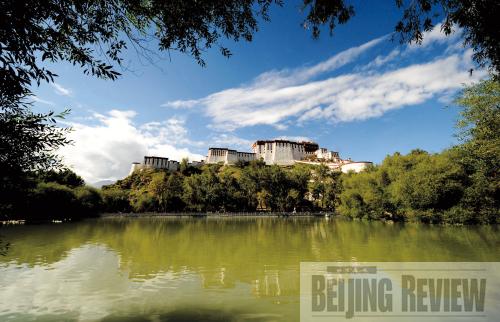|
Nyima Cering said problems exist all the way down to the building's foundations. He said underground passageways, which look like the basements of buildings constructed by the Han people, also serve a load-bearing function. If they were to collapse, the whole building would fall down. Fortifying the passageways is a major focus of the project.
 |
|
REVITALIZATION: The Potala Palace shown after renovation on August 22, 2009 |
Workers first had to remove garbage from the passageways to understand their condition. High levels of dust in these passageways meant crews had to wear layers of facemasks to get into the passageways, but some still suffered damage to their windpipes and noses.
One of the passageways runs 18 meters under the palace and is very small—it can hold only two workers at a time. It was difficult to clear the debris from the tunnel but eventually it was cleared along with the others and fixed.
Most of the workers are Tibetans who are very familiar with the traditional construction methods. Around 189,000 workers are working on the project, which is a major boost to the local economy, said Nyima Cering.
The long-term project has also cultivated a group of professionals who are experts at traditional construction. Nyima Cering said a number of young college graduates who are skilled in mural preservation participated. Before the renovation, there had been only one company in Tibet qualified for that type of work. Now there are six.
The Potala Palace, a combination of Tibetan construction art and ethnic culture, is considered a precious treasure of China. The Norbu Lingka Palace is the perfect complex of Tibetan and Han construction features and is also the highest-altitude garden in the world. The Sagya Monastery is the birthplace of the Sakya school of Tibetan Buddhism.
But after years of decay, all the three sites developed problems. It has been considered an urgent task to protect and save these precious sites.
On June 26, 2002, the project for the preservation of the three sites began with an investment of 380 million yuan ($55.88 million) from the Central Government, an unprecedented amount in China's history.
On August 24, 2009, the Central Government invested 570 million yuan ($83.5 million) to preserve 22 other historic sites. Many of the Tibetan sites are suffering from the corrosive effects of time. After one is restored, problems pop up in another, so it is a continuing mission that requires time and money. But the money collected by the temples is far from enough. Since 2006, the government of the autonomous region has invested more than 10 million ($1.47 million) on cultural site preservations, said Liu Shizhong, vice director of the regional cultural heritage bureau.
The funding mainly comes from the state. Since Tibet's democratic reform in 1959, historic site preservation has been a major part of Tibet's overall development program. The Central Government has allocated a total of 1.4 billion yuan ($205 million). From the 1980s to the end of the 20th century, more than 300 million yuan ($44 million) had been allocated for ethnic cultural heritage preservation projects in Tibet. | 